My initial BananaPi M2 Zero review highlighted issues with the onboard WiFi performance and it got me thinking, is an external WiFi antenna worth it? The board itself has a U.FL antenna connection, allowing us to use an external WiFi antenna to, in theory, boost the reception on the device.
Being the sucker for AliExpress that I am, I decided that the “best” course of action would be to source a variety of antenna options to see if spending the extra couple of dollars on antennas would make a meaningful difference to performance. I say “best” because I’m fully aware that this is not the most technical of tests but hey, have you seen the rest of my content?
As the MangoPi MQ Pro also has a U.FL connector, I wanted to see if we could squeeze anything else out of it. It already scored quite highly in previous tests but there’s no harm in trying!
Table of Contents
The Test Setup
- Ubiquiti UniFi U6-LR Access Point
- 3-metre distance with a line of sight
The access point and SBC in each test were 3 metres apart, with the access point on the wall on one side and the Banana Pi BPI-M2 Zero/Mango Pi MQ Pro boards sitting on a desk on the other side of the room.
Each antenna was connected using the same U.FL to SMA adapter where possible to reduce the number of variables and both tests were performed on 2.4GHz on Channel 10.
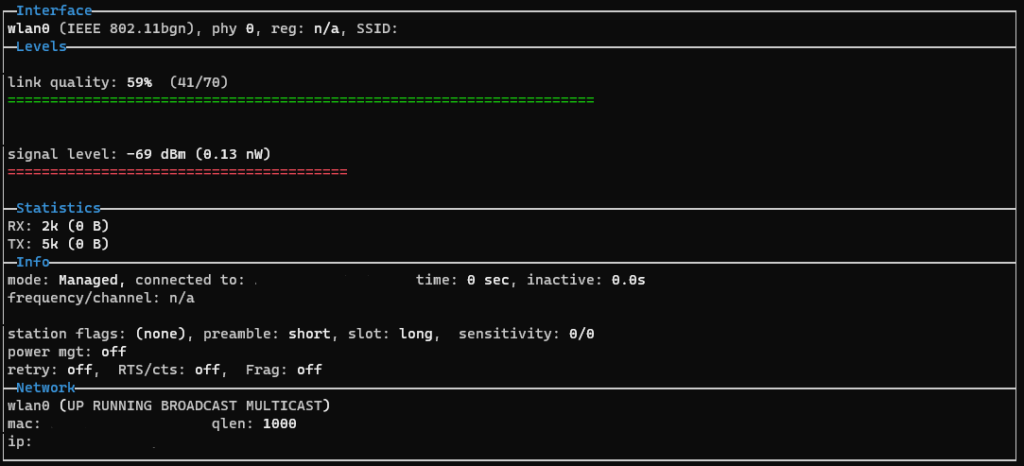
iperf3 was the test software of choice for throughput (a 10-minute run in either direction with 8 parallel threads, connected to an idle Gbit server connected to a Ubiquiti UniFi 16-port PoE switch) with wavemon used as a quick overview of wireless connection information.
Antennas Used
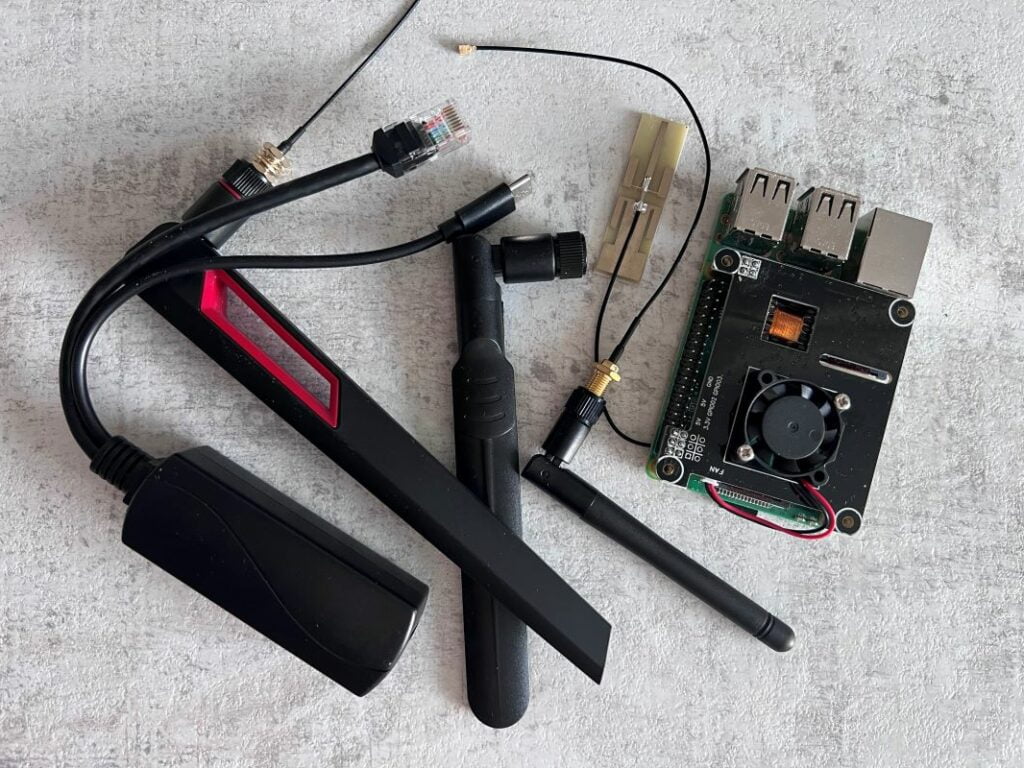
Unfortunately, being the cheap-ass I am, there are no visible brands on these antennas and the AliExpress listings are no help either. To differentiate, I’ll be calling them by their dBi rating. In the lineup we have 2 8dBi Dual-Band antennas, one is a PCB antenna and the other is the flatter black antenna you see above. The larger red and black antenna that screams gaming router is a 12dBi Dual-Band item and the smallest antenna on the right-hand side is a 3dBi 2.4GHz only antenna.
BananaPi M2 Zero WiFi Antenna Throughput
Interestingly, in this test setup, we saw better BananaPi M2 Zero WiFi performance than we did in our 1m line of sight Pi Zero comparison testing.
The raw numbers don’t look incredibly different but in percentage terms, going from the onboard antenna hardware to an external antenna gives around 10-15% gains in raw throughput.
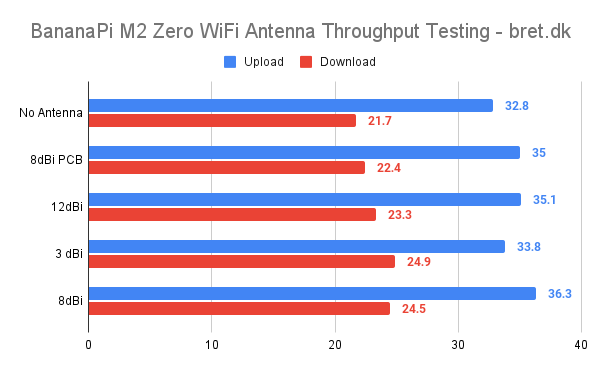
During the 10-minute test period, there was a massive amount of variation in the speeds. During the downloads, I saw it hopping between 7, 14, 22, and 39Mbit so whilst the signal strength and average throughput increased, the stability was still lacking. Uploads were pretty stable overall.
BananaPi M2 Zero WiFi Antenna Signal Strength
The signal strength and link quality are where we see the biggest increases though and the graph speaks for itself. We max out the link quality with all of the external antennas and signal levels get much better, as expected. We don’t see as big gains from the actual throughput as we’re nearing the limits of the hardware itself but if you want to ensure your connection is as strong as possible, an external antenna is a clear benefit.
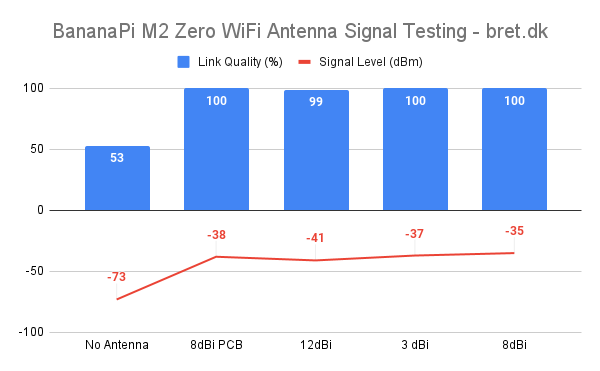
MangoPi MQ Pro WiFi Antenna Throughput
As mentioned, the MQ Pro also has the relevant connector for these antennas so I wanted to see what benefits that could bring too. By default, the performance was already better with its TL8723DS WiFi chip but we did see increases across the board (15-20%) on the upload side. With downloads, however, we actually saw drops of around 5% on all but the 3 dBi antenna.
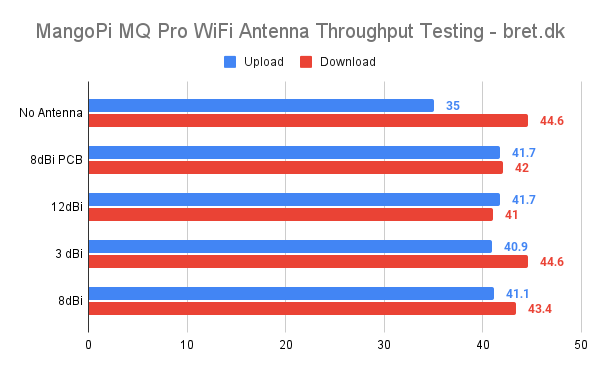
The MangoPi MQ Pro didn’t suffer from the same fluctuation during the test whilst either uploading or downloading so it seems that the overall experience may be a little more stable on the MQ Pro.
MangoPi MQ Pro WiFi Antenna Signal Strength
The Mango Pi MQ Pro’s TL8723DS WiFi signal strength didn’t quite get the boosts in signal quality/levels seen on the BPI-M2-ZERO but it was still better than without.
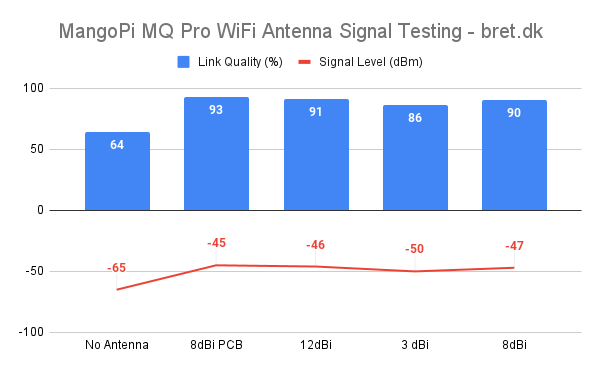
Does the BananaPi M2 Zero need an antenna?
Well, to round it up, it’s going to depend on your specific situation. I’d love to have tested every possible combination of distance, walls etc but I didn’t, sooo..
At 3m and no obstacles, it’s a clear benefit on the BananaPi board, with near enough double the signal quality and a link quality double that of the board on its own.
If having an extra antenna is something you’re able to do with your setup and you need a stronger signal then I’d personally go with the smaller, 8dBi PCB Antenna as it consistently provided great performance for the size of it. The different antennas will be better in certain situations and really, my test doesn’t do them the greatest of justice but hopefully, it helps to show what a few dollars can do if you really need to boost your WiFi signal/performance on these boards.
2 comments
Hey bud, great write up….
AFAIK the bana Pi doesn’t have an onboard chip antenna like the regular Pi Zero does, so this probably explains the terrible performance without an antenna at all!
Cheers
Thanks! Yup, that makes sense. With every other board in the same boat, there has been an included antenna, it would be great to see Sinovoip do the same. I’m sure they can source them at sufficient quantities to not cause too big of a dent in their bottom line :D